





 |
 |
 |
 |
 |
 |
| Andrys Basten | profile | all galleries >> TURKEY Photos - Anatolia, 2004, with Canon Elph >> Photos: Istanbul Archaeological Museums: Alexander the Great | tree view | thumbnails | slideshow |
|
We didn't have much time to spend at the Istanbul Archaeological Museums, but what we saw was stunning. Photos of the Alexander the Great sculptures that are there (statue and bust) are less easy to find online than those of the European sculptures, although the bust/head is seen on the cover of many classical history books and is considered more realistic than the one in The Louvre. It's from Pergamon (AKA Pegamum or Bergama), which we also visited. Here's more info on the Alexander Sarcophagus, which was discovered in 1887, in Sidon and dates from the end of 4 BC (between 317-312's.). The high-reliefs in the sarcophagus photos are best seen in the enlarged versions rather than just the thumbnails. Beautiful work. The rooms are kept very dark, to emulate how it looked/felt when they found them. They don't allow use of flash. The Treaty of Kadesh tablets (copies from that time - 1269 BC) were made in two languages, one for the Hittites (Hattusilis II) and one for the Egyptions (Ramses II). It's said that the Hittite one (in Akkadian) is closer to the actual agreement but the basic points are the same in each. The original Egyption one was on the Karnak temple. |
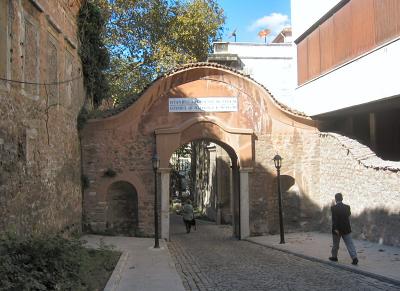 Entrance to Istanbul Archaeological Museums |
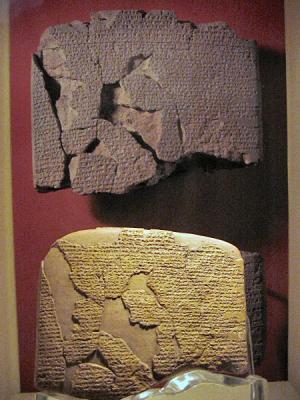 2 copies of Treaty of Kadesh, the first written peace treaty ever, 1269 BC This was taken through a glass case and fuzzy. Brown tablet enlargement is clearer. |
 The Treaty of Kadesh was responsible for 70 years of peace in the middle east. (How might this ever happen again?) These Hittite cuneiform tablets are two
|
 Treaty of Kadesh. This one is clearer. Peace via baked clay... Here's a good page to see what the parties agreed on, along with the background of the battle(s).
|
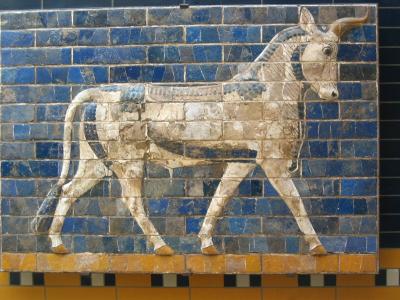 Glazed-brick tile mosaic of Persian bull, from Babylon's Ishtar Gate Now at the Nat'l Archaeological Museums, this is from Babylon's main entrance, from the reign of
|
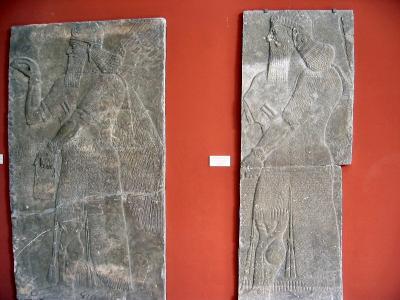 Low--relief images but very elegant Figure on left is beautiful.
|
 Low reliefs with broken pieces restored From the Museum of Ancient Orient also. |
 At the Archaeological Museum itself (I could spend days there.) Relief on one of the smaller pieces there. |
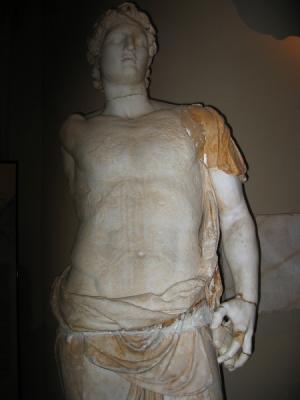 Alexander - Default flash on camera went off against museum rules The shadow just happens to mask the missing arm of the statue. |
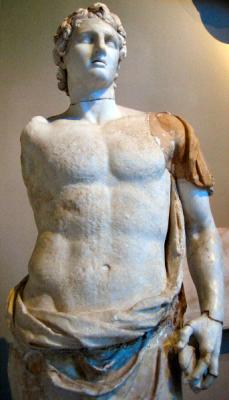 Alexander - W/o flash, better for forearm marble (veins too) See Phil Hartland's info. |
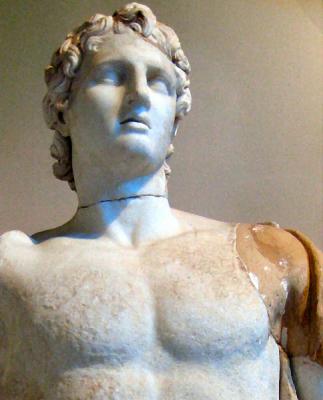 Alexander statute - detail from last shot From Magnesia on the Sipylos |
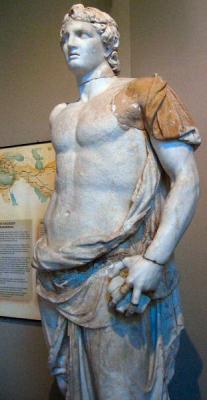 Alexander statue - from another angle By Menas, a sculptor from Pergamum/Perganon |
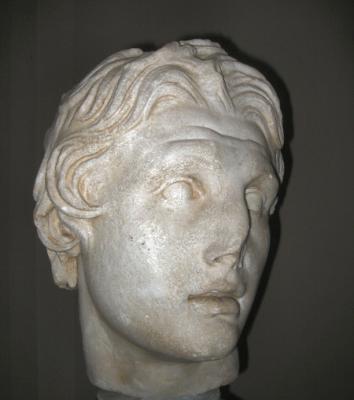 Famous Alexander head from the excavation at Pergamon. 2nd C. Used flash, though a no-no, on this excellent piece. Here's another view, online. |
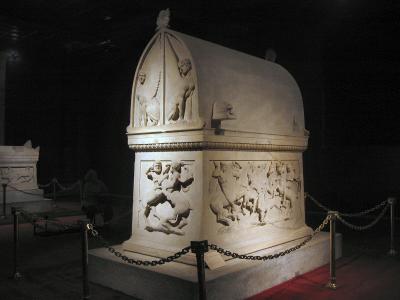 "Lycian Sarcophagus" - 5th C. BC No flash. All photos here are long-exposure. This came from the necropolis of King of Sidon. |
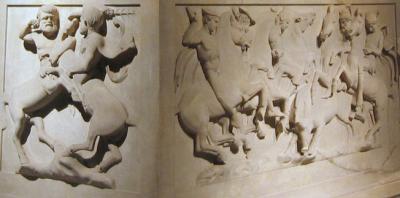 Enlarged the bottom relief of the sarcophagus. This was found by Osman Hamdi in 1877 and brought here. In this photo you see the fight of
|
 Previous relief from different angle |
 Centaurs battling, in a relaxed way, over a deer. All the figures on this sarcophogus seem almost tranquilized but the faces are very expressive
|
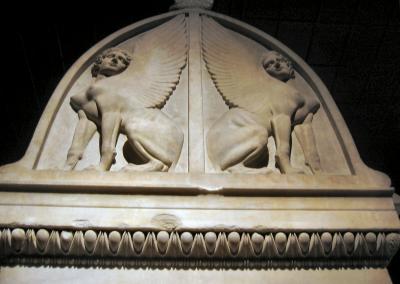 The area above, on the lid. Very strange-looking sphinxes? Is this what they mean when they say someone is sphinx-like? :-) Sometimes termed bird-women,
|
 Boar-hunt relief on one of the long sides (seen in sarcophagus photo) |
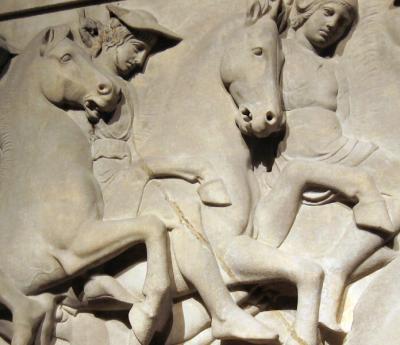 Enlarged portion. Strangely placid expressions on this panel. |
 Another area of the side panel |
 Detail from previous photo |
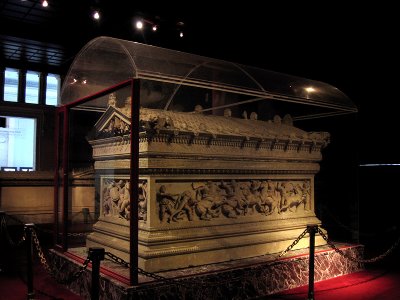 "Alexander Sarcophagus" - 4th C. BC, in the shape of a temple Made from pentalic marble, this was thought to be his sarcophagus but that's been disproved. His
|
Alexander sarcophagus full-panel detail from previous shot, lightened. Alexander on the left, with a cape. There are photos of a fantastic illustration identifying the figures on the sides of this |
 More detail from Alexander "hunting" panel Greek and Persians are shown hunting together, unified under Macedonian rule. Alexander at left. |
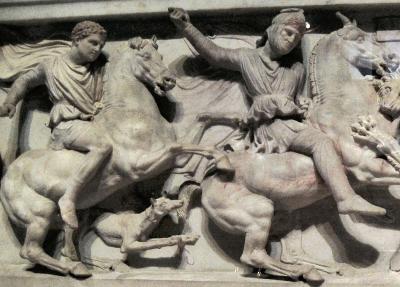 Enlarged portion of previous photo, with Alexander on left While others favor Mazaeus as owner, most feel the sarcophagus belonged to King Abdalonymos of
|
 Alexander sarcophagus: other side -- full panel, but roped off There are photos of a fantastic illustration identifying the figures on the sides of this |
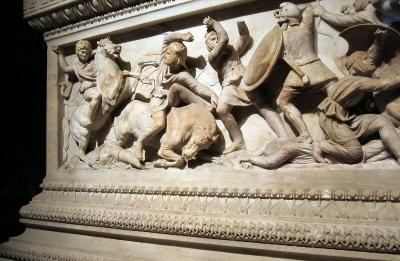 Alexander at far left, on this frieze The full shot earlier shows only the other side. This depicts the Battle of Issus,
|
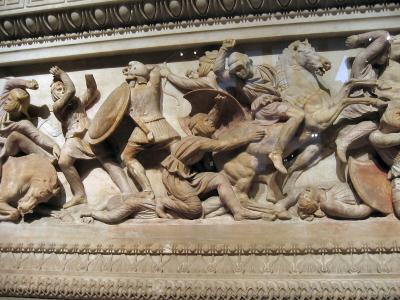 Same panel, continued. Some original paint remains. The weapons held by the soldiers and hunters were plated in gold or silver, but grave robbers
|
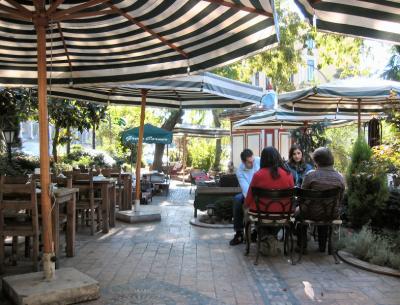 The Green Corner cafe - table at right was overturned later by a thief running from pursuers. Luckily, by that time, no one was sitting there any longer.
|
| comment | share |
| Andrys Basten | 06-May-2016 08:47 | |
| Guest | 16-Feb-2016 20:49 | |
| E. | 08-Jan-2015 20:19 | |
| Andrys Basten | 22-May-2013 08:33 | |
| Ted Calkins | 20-May-2013 18:53 | |
| carlin d. small | 07-Sep-2012 13:57 | |
| Andrys Basten | 10-Oct-2011 12:21 | |
| Shashank | 09-Oct-2011 07:29 | |
| Guest | 03-Jul-2011 11:38 | |
| Rita Fairchild | 16-Jan-2010 19:20 | |
| Guest | 16-Nov-2009 15:35 | |
| Rita Fairchild | 02-Aug-2009 08:39 | |
| Andrys Basten | 24-Mar-2009 01:55 | |
| Bill C | 24-Mar-2009 01:15 | |
| Guest | 22-Mar-2009 14:29 | |
| Andrys Basten | 31-Jan-2009 11:10 | |
| Peter Horvathy | 30-Jan-2009 13:31 | |
| Guest | 13-Jan-2009 23:15 | |
| Shoumick | 07-Jan-2009 11:11 | |
| rocky Gadelha | 28-Jul-2008 06:45 | |
| Amie Ryan | 07-Apr-2008 22:23 | |
| Hershel Shanks | 11-Mar-2008 01:15 | |
| Guest | 27-Nov-2007 16:36 | |
| Andrys Basten | 01-Aug-2007 21:11 | |
| Rita Fairchild | 01-Aug-2007 18:59 | |
| Philip Nickson | 19-May-2007 14:05 | |
| tay | 11-Apr-2007 01:51 | |
| Brian | 03-Jan-2007 07:13 | |
| Grace | 07-Aug-2006 00:03 | |
| Andrys Basten | 23-Jul-2006 00:45 | |
| Athene | 22-Jul-2006 19:39 | |
| Andrys Basten | 04-Jul-2006 20:50 | |
| callie | 04-Jul-2006 18:31 | |
| Louise | 10-Jun-2006 12:15 | |
| Guest | 20-Jan-2006 18:20 | |
| Andrys Basten | 13-Jan-2006 09:24 | |
| Guest | 12-Jan-2006 22:57 | |
| vanilla | 07-Dec-2005 04:09 | |
| Andrys Basten | 30-Dec-2004 00:06 | |
| amyntoros | 29-Dec-2004 14:50 | |